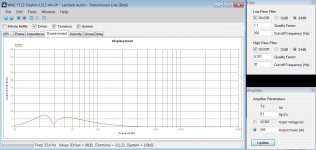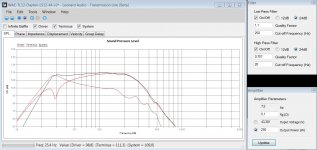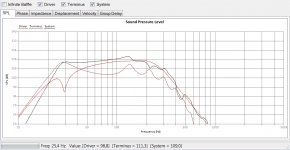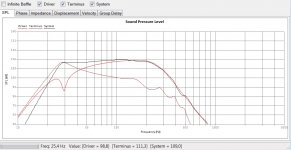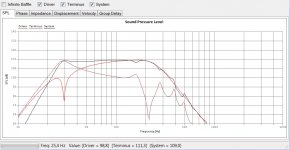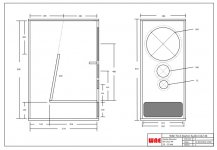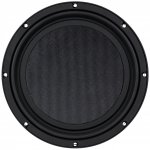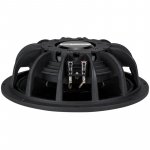12" TL version design for the PM-DMT
As previously discussed, it would be nice to have a 2x Transmission Line LF.
Here is a nice start with a Dayton LS12-44, which has a flat cone, comes at around 140 Euro's, sexy..
Apart from being sexy, it appears to love TL's. +-3 dB point is around 25 Hz in a cabinet with internal dimensions of 76 High, 57 Deep and 35 wide (centimetres that is).
I used Leonards TL software. Also, to figure out where the damping needs to go, I slice up the TL, so to be able to find those places by adding High damping as a check. That way you can see the effect in the Freq. response and xmax. Typically, I find that there a 3 (almost obvious) spots which require some kind of damping.
- The closed end of the TL (works for almost the entire spectrum).
- Right around the driver (tame the low-mid 1e order? dip, which is also controlled by off-setting the driver)
- In the last segment at the open end of the TL, control the high end of the spectrum).
kind regards.
As previously discussed, it would be nice to have a 2x Transmission Line LF.
Here is a nice start with a Dayton LS12-44, which has a flat cone, comes at around 140 Euro's, sexy..
Apart from being sexy, it appears to love TL's. +-3 dB point is around 25 Hz in a cabinet with internal dimensions of 76 High, 57 Deep and 35 wide (centimetres that is).
I used Leonards TL software. Also, to figure out where the damping needs to go, I slice up the TL, so to be able to find those places by adding High damping as a check. That way you can see the effect in the Freq. response and xmax. Typically, I find that there a 3 (almost obvious) spots which require some kind of damping.
- The closed end of the TL (works for almost the entire spectrum).
- Right around the driver (tame the low-mid 1e order? dip, which is also controlled by off-setting the driver)
- In the last segment at the open end of the TL, control the high end of the spectrum).
kind regards.
Attachments
Last edited:
Damping a TL with Leonard software (as a start)
I guess that should be "at least 3 spots...". To be completely honest, I still have to build my first TL, which as I understand will improve my panel fixing skills by a nice margin. It would take a lot of adding / changing and removing damping material while listening and measuring. Construction of the test TL so that one side panel can be screwed on and off a lot of times without leaking.
Just hoped that by doing it as described in my previous post. If we can design a TL with this software and take our trust in it, why would applying damping material with the same software be WAY off. So, as a start I currently trust the software and therefore the damping starting point.
Question will always be, HOW does it SOUND. Most likely, we could damp all the live out of the TL and still have a nice graph. So testing and measuring comes in as a must.
What I did here is apply the bare minimum and have the SPL level as least influenced as possible. Assuming that this would keep the TL alive...
I added 3 frequency graphs to show the different effects;
- First graph with NO damping in the last (open ended) segment
- Second graph with NO damping around the driver
- Third graph with NO damping at the closed end of the TL
Look at the SPL level in the effective area we want to use (25 - 250 Hz). The damping at the closed end impacts the SPL mostly.
comments / corrections always welcome.
kind regards.
Typically, I find that there a 3 (almost obvious) spots which require some kind of damping.
- The closed end of the TL (works for almost the entire spectrum).
- Right around the driver (tame the low-mid 1e order? dip, which is also controlled by off-setting the driver)
- In the last segment at the open end of the TL, control the high end of the spectrum).
kind regards.
I guess that should be "at least 3 spots...". To be completely honest, I still have to build my first TL, which as I understand will improve my panel fixing skills by a nice margin. It would take a lot of adding / changing and removing damping material while listening and measuring. Construction of the test TL so that one side panel can be screwed on and off a lot of times without leaking.
Just hoped that by doing it as described in my previous post. If we can design a TL with this software and take our trust in it, why would applying damping material with the same software be WAY off. So, as a start I currently trust the software and therefore the damping starting point.
Question will always be, HOW does it SOUND. Most likely, we could damp all the live out of the TL and still have a nice graph. So testing and measuring comes in as a must.
What I did here is apply the bare minimum and have the SPL level as least influenced as possible. Assuming that this would keep the TL alive...
I added 3 frequency graphs to show the different effects;
- First graph with NO damping in the last (open ended) segment
- Second graph with NO damping around the driver
- Third graph with NO damping at the closed end of the TL
Look at the SPL level in the effective area we want to use (25 - 250 Hz). The damping at the closed end impacts the SPL mostly.
comments / corrections always welcome.
kind regards.
Attachments
The TL design squeezed into a cabinet
Next, I made a sketch of the cabinet that is to hold this design.
Personally I like this 2 fold, 3 element version. It is very simple to put in to a cabinet.
Looking at the picture I added of the TL design;
The second element will be 180 degrees turned and placed against the first element. The third element goes against the bottom of the first and second element. Both the first and second element have the same length. The length of the third element is the sum of the closed end size (a) and the smallest side of the second element (b) and the thickness of one panel (18mm).
Note: the dotted line can be ignored, it's a slice of the first element that I used to determine if another damping spot was required. With the Leonard software, you can split an element. You get an new element within the existing element so to speak which you can move around and change in size. Adding damping to this slice shows the effect on the frequency graph.
Second picture is the design, in this case still with a separate MF and HF driver. For our PM-DMT, we need to put hold of the closed cabinet for the coaxial into this design. It's about 3 litres, so not a big deal.
Note: Sizes could be in-accurate, have to do a final calc.
kind regards.
Next, I made a sketch of the cabinet that is to hold this design.
Personally I like this 2 fold, 3 element version. It is very simple to put in to a cabinet.
Looking at the picture I added of the TL design;
The second element will be 180 degrees turned and placed against the first element. The third element goes against the bottom of the first and second element. Both the first and second element have the same length. The length of the third element is the sum of the closed end size (a) and the smallest side of the second element (b) and the thickness of one panel (18mm).
Note: the dotted line can be ignored, it's a slice of the first element that I used to determine if another damping spot was required. With the Leonard software, you can split an element. You get an new element within the existing element so to speak which you can move around and change in size. Adding damping to this slice shows the effect on the frequency graph.
Second picture is the design, in this case still with a separate MF and HF driver. For our PM-DMT, we need to put hold of the closed cabinet for the coaxial into this design. It's about 3 litres, so not a big deal.
Note: Sizes could be in-accurate, have to do a final calc.
kind regards.
Attachments
Here is a nice start with a Dayton LS12-44, which has a flat cone, comes at around 140 Euro's, sexy..
This is the Dayton LS12-44. Something different

kind regards.
Attachments
Speaking of which there are some very modern coaxial speakers such as Geithains and Genelec the Ones for inspiration
Thanks, looking into the generic's, what's "behind" slot panel? Hhmmm
kind regards.
Thanks, looking into the generic's, what's "behind" slot panel? Hhmmm
kind regards.
Genelec has some public papers on the design with photos, remember reading them some time ago. there are oval shaped woofers top and bottom behind the slots. I don't find them now though... here is one paper on it Magazine Articles | Genelec.com
some more info Acoustically Concealed Woofers (ACW™) Technology | Genelec.com
Last edited:
I guess that should be "at least 3 spots...". To be completely honest, I still have to build my first TL, which as I understand will improve my panel fixing skills by a nice margin. It would take a lot of adding / changing and removing damping material while listening and measuring. Construction of the test TL so that one side panel can be screwed on and off a lot of times without leaking.
I say: go for it.
Make the first with cheap MDF and few screws to test damping. I'd go from no damping to full damping and backwards. With such a simple box (I expected more convolutions and lenght
My own first attempt (no software used
Have fun,
M.
Genelec has some public papers on the design with photos, remember reading them some time ago. there are oval shaped woofers top and bottom behind the slots. I don't find them now though... here is one paper on it Magazine Articles | Genelec.com
some more info Acoustically Concealed Woofers (ACW™) Technology | Genelec.com
THANKS!
Just the one 12" per side then?
Well, as a starter to see if I can handle this.
I'm shure it will be a series 10" 12" (15") single with a coax and same with 2x LF, for the bigger bang so the speak
kind regards.
I say: go for it.
Make the first with cheap MDF and few screws to test damping. I'd go from no damping to full damping and backwards. With such a simple box (I expected more convolutions and lenght) it shall be easy.
My own first attempt (no software used) was transforming some cheap Aywa little surround speakers (3,5" woofer) into test speakers with an 83 X 40cm PCM-like box. The total length of TL is around 2,8m. Obviously, they are not perfect, but they serve its purpose and produce some articulate bass.
Have fun,
M.
I will, in the end. Only issue is Time, money, girlfriend (in random order, that is...
 ) Ooh ya, and a studio to test them in (also on the list for this year, the shed is waiting).
) Ooh ya, and a studio to test them in (also on the list for this year, the shed is waiting).kind regards.
Unless you are wedded to the transmission line idea you could consider the £150 BMS 12S330.
Works in surprisingly small BR* cabs and a small cab = a light (and possibly cheaper) cab. Never simmed it in a T/L but I doubt it would be ideal. Functional may be...
* 60L for -3dB at 32Hz
Works in surprisingly small BR* cabs and a small cab = a light (and possibly cheaper) cab. Never simmed it in a T/L but I doubt it would be ideal. Functional may be...
* 60L for -3dB at 32Hz
OK, price wise I can see that. I have an "un founded" objection against rubber hung drivers. When mentioned, I always see those YouTube films on BOOMboxes in cars. The only thing you here is the rattling by meltdown of the microphone in their Mobile phone. The image you see is fluffy cone movements, kinda like a big blur, moving like centimetres in & out. Ooh, and the champions show the roof and windows of their car flexing.. 

 Look mah, my car comes alive ...
Look mah, my car comes alive ...
Although not supported by facts, also don't see them that much in the studio world, at least up until the last years or so. IS that because they matured?
kind regards.

 Look mah, my car comes alive ...
Look mah, my car comes alive ...Although not supported by facts, also don't see them that much in the studio world, at least up until the last years or so. IS that because they matured?
kind regards.
Last edited:
Uuhhmm, it's already there (sort off)
Form the Kingdom brochure ;
;
Tannoy has for many years been at the forefront of development of wide bandwidth technology. The design philosophy behind the Kingdom range was driven by the demand for the technical performance of loudspeakers to match advances in digital software and hardware (e.g. SACD/ DVDA).
All models utilise the Tannoy Dual ConcentricTM drive unit, a world famous loudspeaker technology unique to Tannoy, to deliver the vast majority of the musical information. The Kingdom and Kingdom 15 use a very highly developed version of this driver - the Tannoy SuperDualTM.
Each model is capable of reproducing extremely wide bandwidth information due to the inclusion of two additional drive units. A supplementary bass driver, resolving frequencies as low as 16Hz, and a SuperTweeterTM, extending high frequency information to 44kHz, provide a dynamic range that offers an unprecedented listening experience.
Except for the Supertweeter, it's this config (12" low and 10" DC) we are looking for. Crossover at 100 Hz & 1.6 kHz 2nd order low pass and 1st order high pass for the HF in the DC. The super tweeter crosses at 16kHz.
So much for the ignorant ... (me that is...)
kind regards.
Form the Kingdom brochure
 ;
;Tannoy has for many years been at the forefront of development of wide bandwidth technology. The design philosophy behind the Kingdom range was driven by the demand for the technical performance of loudspeakers to match advances in digital software and hardware (e.g. SACD/ DVDA).
All models utilise the Tannoy Dual ConcentricTM drive unit, a world famous loudspeaker technology unique to Tannoy, to deliver the vast majority of the musical information. The Kingdom and Kingdom 15 use a very highly developed version of this driver - the Tannoy SuperDualTM.
Each model is capable of reproducing extremely wide bandwidth information due to the inclusion of two additional drive units. A supplementary bass driver, resolving frequencies as low as 16Hz, and a SuperTweeterTM, extending high frequency information to 44kHz, provide a dynamic range that offers an unprecedented listening experience.
Except for the Supertweeter, it's this config (12" low and 10" DC) we are looking for. Crossover at 100 Hz & 1.6 kHz 2nd order low pass and 1st order high pass for the HF in the DC. The super tweeter crosses at 16kHz.
So much for the ignorant ... (me that is...)
kind regards.
Well if you are prejudiced against rubber-surround drivers you wouldn't like the Volt either! 
How come you've already decided on a specific crossover topology?
Wouldn't it be wiser to pick a co-axial first and then use whatever crossover type works best?
Btw and on paper your Faital 8HX200 is what I would have chosen. I think it'll be hard to find something equal or better cheaper. Seems a good match with one or two 12" woofers too.
Are you aiming for passive, active or both options?
Active it would need some eq which is easy in DSP, passive it would need some creative crossover design. I've got some ideas which might lead to a flat frequency response but I do not know what the pay off in the phase response might be. Probably acceptable though...
How come you've already decided on a specific crossover topology?
Wouldn't it be wiser to pick a co-axial first and then use whatever crossover type works best?
Btw and on paper your Faital 8HX200 is what I would have chosen. I think it'll be hard to find something equal or better cheaper. Seems a good match with one or two 12" woofers too.
Are you aiming for passive, active or both options?
Active it would need some eq which is easy in DSP, passive it would need some creative crossover design. I've got some ideas which might lead to a flat frequency response but I do not know what the pay off in the phase response might be. Probably acceptable though...
Well if you are prejudiced against rubber-surround drivers you wouldn't like the Volt either!
Now you mention it, I had the 15" Volt in mind and just assumed the 12" would have the same traditional surround
How come you've already decided on a specific crossover topology?
Wouldn't it be wiser to pick a co-axial first and then use whatever crossover type works best?
That's just because I am working on 2 threads at the same time, it was intended for the Tannoy SRM thread.
I liked the idea of optimising the Tannoy original cross-over.
So actually, we need to have a 3-way here, since I like the Faital 8HX200 and can get them cheap (use mostly Faital's in my PA line, so have an agreement with the Dutch supplier). Seems we need to design the cross-over for the faital and add the low pass on the Dayton (which most likely will be the test version LF in a TL).
Btw and on paper your Faital 8HX200 is what I would have chosen. I think it'll be hard to find something equal or better cheaper. Seems a good match with one or two 12" woofers too.
Agreed. Thinking making both, the 1x12" AND 2x12" with one 8HX200. Same for the 1x10" and 2x10".
Are you aiming for passive, active or both options?
Active it would need some eq which is easy in DSP, passive it would need some creative crossover design. I've got some ideas which might lead to a flat frequency response but I do not know what the pay off in the phase response might be. Probably acceptable though...
Actually I was thinking of going for active / DSP based first, have a mini DSP laying around doing nothing (bought it for test purposes) as well as a DBX PA2 (used for demo) AND a 4x 700 WATT @ 4ohm digital amp.
Also as a serious option for the "production version", I am looking at the Hypex Fusion amp FA253. It's 2x 250 + 1x 100 watt 3-way plate-amp including DSP with programmable preset's, time alignment, phase correction, the whole shebang. Comes around 325 euro's I heard.
If you would like at the whole package, this would cost around 800 Euro for an active DSP controlled programmable 600 Watt 23 - 20000 Hz +- 3dB, 2x12" @ 1x8" TL based coaxial 3-way studio main monitor that would match up with much of the currently available products.
Passive is my second option but not that easy I guess, but idea's are VERY welcome.
kind regards.
Sounds like a plan!
Thanks, proceed from here to see if we reach our goals.
Remember that Hypex specs at 4Ω, not 8.
For the Hypex (250 - 250 100 watt), the Dayton LS12 & Faital 8HX200, it would give;
LF = 4Ω (2x 8Ω parallel) @ 250watt = 115dB
MF (Coax LF) = 8Ω @125 watt = 116dB
HF (Coax HF) = 8Ω @ 50 watt = 124 dB (estimated)
So the HF needs to be tamed as te be expected. It will only handle 30 watts max = 122dB (@32watt). So it needs only 8 watts for 116 dB.
So we need 250 - 125 - 8 watts at the above given load which will give 115 - 116 - 116 dB. We're safe.
Side note: 116 dB @ 2 - 3 meters distance is quite a handful, AKA loud enough I guess
And rubber is ok, it is foam surrounds you want to avoid.
Must be since PMC uses the Volt 12", they know what they do. Thanks for pointing out. Guess it takes some careful selection. AND I need to stay awake, the choice for the Dayton LS10 & LS12 ALSO have rubber surrounds. Point taken.
Next step:
I will make up a detailed design. The Coax needs to sit IN the TL, which will only take 2 -3 liter. I'll check but most likely, since we want to use the 8HX200 above 200 HZ or so, a VERY small closed box will do. (build a closed box that follows the contour of the loudspeaker).
p.s. I already did check to put a small (3 liter) object within the TL in Leonard software, ZERO Impact.
kind regards.
- Status
- This old topic is closed. If you want to reopen this topic, contact a moderator using the "Report Post" button.
- Home
- Loudspeakers
- Multi-Way
- The POOR man's Tannoy DMT - AKA "The PM-DMT"
